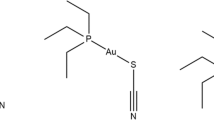Abstract
In the last few years gold(III) complexes have attracted growing attention in the medicinal chemistry community as candidate anticancer agents. In particular some organogold(III) compounds manifested quite attractive pharmacological behaviors in preclinical studies. Here we compare the chemical and biological properties of the novel organogold(III) complex [Au(bipydmb−H)(NH(CO)CH3)][PF6] (Aubipyaa) with those of its parent compounds [Au(bipydmb−H)(OH)][PF6] (Aubipyc) and [Au2(bipydmb−H)2)(μ−O)][PF6]2 (Au2bipyc), previously synthesized and characterized. The three study compounds were comparatively assessed for their antiproliferative actions against HCT-116 cancer cells, revealing moderate cytotoxic effects. Proapoptotic and cell cycle effects were also monitored. Afterward, to gain additional mechanistic insight, the three gold compounds were challenged against the model proteins HEWL, RNase A and cytochrome c and reactions investigated through UV–Vis and ESI–MS analysis. A peculiar and roughly invariant protein metalation profile emerges in the three cases consisting of protein binding of {Au(bipydmb−H)} moieties. The implications of these results are discussed in the frame of current knowledge on anticancer gold compounds.









Similar content being viewed by others
References
Ahmed TJ, Knapp SMM, Tyler DR (2011) Frontiers in catalytic nitrile hydration: nitrile and cyanohydrin hydration catalyzed by homogeneous organometallic complexes Coord. Chem Rev 255:949–974
Allen FH (2002) The Cambridge Structural Database: a quarter of a million crystal structures and rising. Acta Cryst B B58:380–388
Altomare A, Burla MC, Camalli M, Cascarano GL, Giacovazzo C, Guagliardi A, Moliterni AGG, Polidori G, Spagna R (1999) SIR97: a new tool for crystal structure determination and refinement. J Appl Cryst 32:115–119
Casini A, Kelter G, Gabbiani C, Cinellu MA, Minghetti G, Fregona D, Fiebig HH, Messori L (2009) Chemistry, antiproliferative properties, tumor selectivity, and molecular mechanisms of novel gold(III) compounds for cancer treatment: a systematic study. J Biol Inorg Chem 14:1139–1149
Cinellu MA, Zucca A, Stoccoro S, Minghetti G, Manassero M, Sansoni M (1996) Synthesis and characterization of gold(III) adducts and cyclometallated derivatives with 6-benzyl- and 6-alkyl-2,2′-bipyridines. J Chem Soc Dalton Trans 22:4217–4225
Cinellu MA, Minghetti G, Pinna MV, Stoccoro S, Zucca A, Manassero M (1998) The first gold(III) dinuclear cyclometallated derivatives with a single oxo bridge. Chem Commun 21:2397–2398
Cinellu MA, Minghetti G, Pinna MV, Stoccoro S, Zucca A (2003) Synthesis and characterization of mononuclear amidogold(III) complexes. Crystal structure of [Au(N2C10H7(CMe2C6H4)-6](NHC6H3Me2-2,6)][PF6]. Oxidation of 4-methyl-aniline to azotoluene Eur. J Inorg Chem 12:2304–2310
Farrugia LJJ (1997) ORTEP-3 for windows - a version of ORTEP-III with a graphical user interface (GUI). Appl Cryst 30:565
Farrugia LJJ (2012) WinGX and ORTEP for Windows: an update. Appl Cryst 45:849–854
Gabbiani C, Massai L, Scaletti F, Michelucci E, Maiore L, Cinellu MA, Messori L (2012a) Protein metalation by metal-based drugs: reactions of cytotoxic gold compounds with cytochrome c and lysozyme. J Biol Inorg Chem 17:1293–1302
Gabbiani C, Scaletti F, Massai L, Michelucci E, Cinellu MA, Messori L (2012b) Medicinal gold compounds form tight adducts with the copper chaperone Atox-1: biological and pharmacological implications. Chem Commun. 48:11623–11625
Gamberi T, Massai L, Magherini F, Landini I, Fiaschi T, Scaletti F, Gabbiani C, Bianchi L, Bini L, Nobili S, Perrone G, Mini E, Messori L, Modesti A (2014) Proteomic analysis of A2780/S ovarian cancer cell response to the cytotoxic organogold(III) compound Aubipy(c). J Proteom 103:103–120
Marcon G, Carotti S, Coronnello M, Messori L, Mini E, Orioli P, Mazzei T, Cinellu MA, Minghetti G (2002) Gold(III) complexes with bipyridyl ligands: solution chemistry, cytotoxicity, and DNA binding properties. J Med Chem 45:1672–1677
Messori L, Marcon G, Orioli P (2003) Gold(III) Compounds as New Family of Anticancer Drugs Bioinorg. Chem Appl 1:177–187
Nardelli M (1995) PARST95 - an update to PARST: a system of Fortran routines for calculating molecular structure parameters from the results of crystal structure analyses. J Appl Cryst 28:659
Nobili S, Mini E, Landini I, Gabbiani C, Casini A, Messori L (2010) Gold Compounds as Anticancer Agents: chemistry, Cellular Pharmacology, and Preclinical Studies Med. Res Rev 30(3):550–580
Sheldrick GM (2008)A short history of SHELX Acta Cryst. A64:112-122
Wang X, Guo Z (2008) Towards the rational design of platinum(II) and gold(III) complexes as antitumour agents. Dalton Trans 12:1521–1532
Acknowledgments
This work was supported by Beneficentia Stiftung (Vaduz, Liechtenstein), Ente Cassa di Risparmio di Firenze and AIRC (IG-16049). MAC gratefully acknowledges the Regione Autonoma della Sardegna for funds financed on L.R. 7/2007 bando 2013. CIRCMSB and Cost Action CM1105 are gratefully acknowledged. The MetMed group and GB acknowledge the group of Prof. A. Arcangeli for the biological studies’ support. LM thanks C.A. Scuotto for the help during his traineeship.
Author information
Authors and Affiliations
Corresponding authors
Electronic supplementary material
Below is the link to the electronic supplementary material.
Rights and permissions
About this article
Cite this article
Massai, L., Cirri, D., Michelucci, E. et al. Organogold(III) compounds as experimental anticancer agents: chemical and biological profiles. Biometals 29, 863–872 (2016). https://doi.org/10.1007/s10534-016-9957-x
Received:
Accepted:
Published:
Issue Date:
DOI: https://doi.org/10.1007/s10534-016-9957-x




